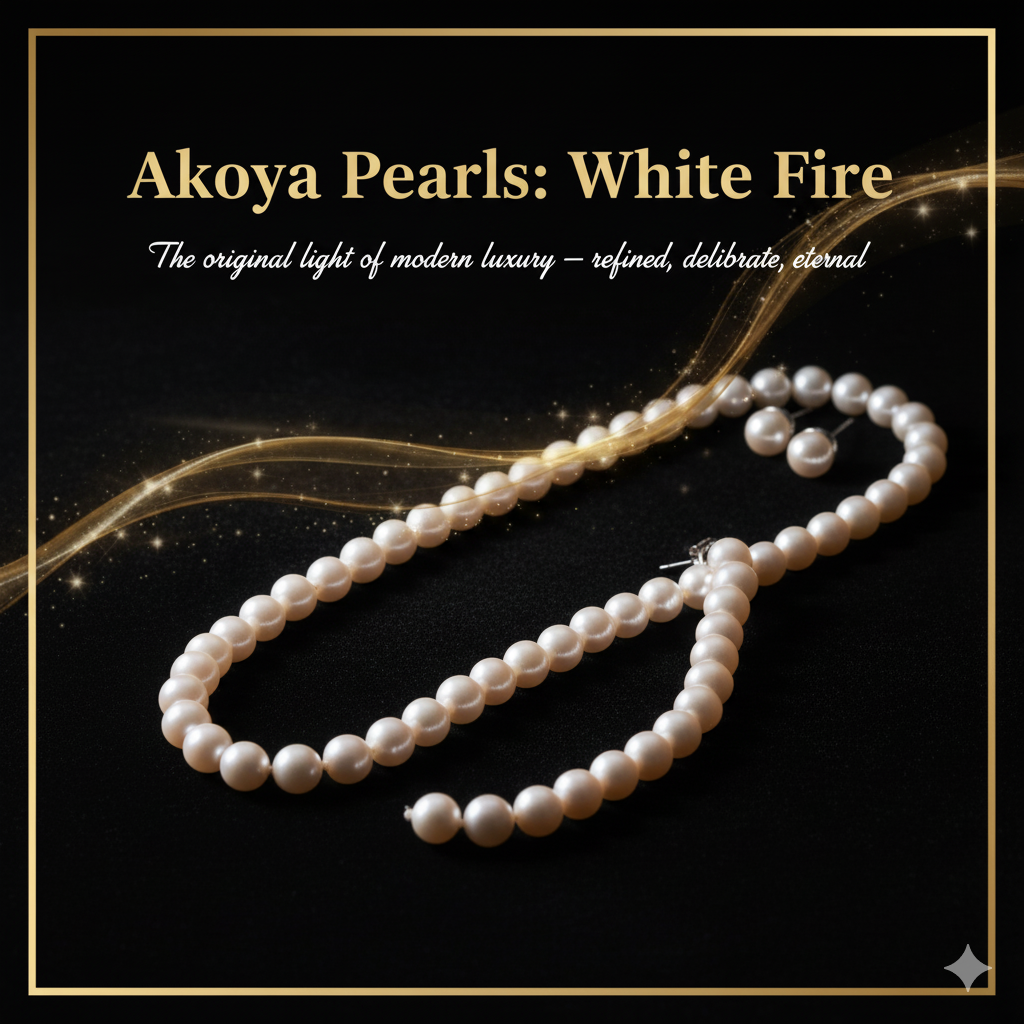Introduction
1) The Light That Changed Everything
Before the South Seas glowed, gold and Tahiti shimmered black, the world first learned to love pearls through Akoya.
They were the dawn of cultured perfection — round, white, reflective, calm, and impossibly pure.
The Akoya pearl was the first to bridge nature and craftsmanship.
It was not a found miracle, but a forged one — a collaboration between the ocean and human patience.
When you hold an Akoya, you hold the moment when luxury became light itself — polished, timeless, and forever poised between nature and art.
2) The Birth of a Revolution
At the turn of the 20th century, Japan was awakening.
Its silk, porcelain, and tea had already enchanted the West — but one man changed everything: Kokichi Mikimoto.
In 1893, after years of failed experiments, he succeeded in culturing a semi-spherical pearl using the small saltwater oyster Pinctada fucata martensii.
By 1905, he perfected the technique for fully round pearls, forever altering the world’s idea of rarity.
What diamonds are to fire, Akoya pearls became to light.
They weren’t just gems; they were proof that beauty could be recreated without diminishing nature — a philosophy deeply Japanese in its grace.
3) The Japanese Soul of Precision
Japan’s coastline — particularly the bays of Mie, Ehime, Nagasaki, and Shikoku — became the sanctuaries of this new art.
Here, the Pinctada fucata oysters were small, delicate, and temperamental, yielding pearls only 2–9 mm in diameter.
The farmers, mostly coastal families, treated them with near-religious care:
- Water salinity was checked daily.
- Each oyster was cleaned by hand.
- Plankton density was monitored by sunlight reflection.
It was not industry. It was ritual.
Every Akoya pearl carried within it the Japanese concept of shibui — understated beauty — and kodawari — meticulous devotion to craft.
4) What Makes Akoya Pearls Unique
| Feature | Akoya Pearl Traits |
|---|---|
| Species | Pinctada fucata martensii |
| Size Range | 2 – 9 mm (rarely up to 10 mm) |
| Bodycolour | White, cream, rose, silver, light gold |
| Overtones | Rose, silver, or ivory |
| Shape | Round to near-round |
| Luster | High, mirror-like, brilliant |
| Cultivation Time | 8 – 24 months |
| Origin | Japan, Vietnam, China |
Akoya pearls are the brightest of all pearls.
Their nacre layers are thin yet extraordinarily uniform, creating a crisp, mirrored glow.
Where South Sea pearls diffuse light like silk, Akoya pearls reflect it like moonlight on glass.
5) The Meaning of “White Fire”
Collectors often describe Akoya pearls as “white fire.”
The term captures their duality: cool to look at, yet emotionally warm.
The light of Akoya pearls is not soft or hazy — it is structured.
It gleams with focus and discipline, like a perfectly cut diamond made of silence.
This luster — technically called orient — arises from micro-thin nacre layers (0.2–0.6 mm) stacked with atomic precision.
To wear Akoya pearls is to wear discipline disguised as grace.
6) The Colour Palette of Perfection
Akoya pearls are rarely pure white. Their magic lies in subtle overtone variations:
- Rose White — the classic bridal hue; romantic, luminous, softly flattering.
- Silver White — modern and cool, echoing platinum tones; popular in couture.
- Cream / Ivory — warm and nostalgic, suited to heirloom strands.
- Gold and Blue Akoyas — rare natural variants, once dismissed, now prized by collectors for their individuality.
Each overtone tells a different emotional story, yet all belong to the same disciplined family of light.
7) From Japan to the World
By the 1920s, Mikimoto pearls were showcased in London, Paris, and New York.
His window displays — ropes of perfect orbs cascading like waterfalls — stunned audiences who had never seen such uniformity.
World War II halted trade, but post-war Japan rebuilt through pearls.
Akoyas became ambassadors of the country’s spirit — resilience polished into beauty.
By the 1960s, no bride in Europe or America felt complete without an Akoya strand.
They became the ultimate symbol of cultivated grace — not showy, not loud, just perfect.
8) The Craft of Culturing
Akoya culturing remains one of the most delicate forms of marine craftsmanship.
- Seeding: A small spherical bead (usually made from Mississippi mussel shell) and a piece of donor mantle tissue are inserted into the oyster.
- Healing: The oyster rests for months to form a pearl sac around the nucleus.
- Growth: It is returned to the sea for 8–24 months.
- Harvest: Divers retrieve oysters and sort pearls by size, surface, and luster.
Out of thousands of oysters, only a few yield near-perfect pearls — less than 5 percent reach gem grade.
Every successful Akoya is a statistical miracle wrapped in patience.
9) The Japanese Eye for Symmetry
While nature creates, Japan edits.
Each pearl is sorted by hand, then matched into strands with a precision jewellers compare to orchestrating sound.
The goal is not mathematical sameness but visual harmony — the rhythm of tone and reflection.
A master stringer might reject a single pearl from a strand of 59 if its overtone falls half a degree off.
That is the Akoya difference: perfection measured in microns and moods.
10) The Modern Couture Era
In the 21st century, Akoya pearls have transcended tradition.
They no longer belong only to the debutante or the wedding aisle.
They appear in architectural jewelry by Dior, Mizuki, Tasaki, Mikimoto, and Alighieri, styled with silk, leather, or gold mesh.
Designers pair their icy symmetry with asymmetrical fashion — proving that Akoyas are timeless precisely because they adapt.
Their elegance is not nostalgic; it’s architectural minimalism in gem form.
11) How They Compare
| Type | Origin | Size | Luster | Character |
|---|---|---|---|---|
| Akoya | Japan | 2–9 mm | Brilliant, mirror | Classic, refined |
| South Sea | Australia / Indonesia | 9–20 mm | Soft, satiny | Regal, serene |
| Tahitian | French Polynesia | 8–17 mm | Metallic | Bold, mysterious |
| Freshwater | China | 3–15 mm | Velvety | Gentle, human |
Akoya remains the archetype — the pearl that defines “pearl.”
12) How to Identify Quality
- Luster: Sharp, mirror reflection with high contrast.
- Surface: Minimal blemishes; smooth texture.
- Shape: True round or near-round.
- Colour: Natural overtones (avoid stark white bleach tones).
- Matching: Uniform glow and rhythm across strand.
- Origin: Japanese Akoyas command premium due to tighter standards.
A perfectly matched strand can take months to assemble — hence the aura of exclusivity.
13) The Symbolism of Discipline
Akoya pearls represent precision, clarity, and emotional control.
Where Tahitians exude mystery and South Seas radiate abundance, Akoyas whisper refinement.
They are the pearls of architects, editors, and poets — those who find beauty in restraint.
To wear Akoya is to say: I don’t chase attention; I hold it quietly.
14) Caring for Akoya Pearls
- Wear often. Skin contact keeps nacre hydrated.
- Last on, first off. Avoid perfumes or hairsprays.
- Clean gently. Wipe with a soft damp cloth.
- Store flat. Keep in silk or felt pouches, never airtight.
- Restring yearly. A strand’s balance depends on even tension.
Over time, Akoya pearls mellow slightly in tone — a natural evolution that deepens their warmth.
15) The Collector’s Eye
Collectors treasure early-era Mikimoto strands for their thick nacre and natural rosé tones.
Pre-1980 Akoyas, when culturing cycles were longer, exhibit depth no longer commercially viable.
In auctions, vintage Japanese Akoyas have begun commanding values comparable to fine South Seas — recognition of their cultural importance.
For collectors, they are not just pearls. They are the first successful fusion of art and biology.
16) Modern Interpretations
Contemporary Akoya jewelry experiments with imperfection — mismatched earrings, floating pearls on gold threads, single studs set in titanium.
Designers call it controlled chaos — honoring Akoya purity while rejecting predictability.
This balance between tradition and reinvention keeps Akoya relevant — it’s no longer your grandmother’s strand; it’s your reflection in white fire.
17) Checklist Summary
✅ Type: Cultured saltwater (Pinctada fucata martensii)
✅ Origin: Japan (primary), Vietnam, China
✅ Size: 2–9 mm (up to 10 mm)
✅ Luster: Bright, mirror-like
✅ Shape: Round / Near-round
✅ Colours: White, rose, silver, cream, rare gold/blue
✅ Cultivation Time: 8–24 months
✅ Meaning: Discipline, elegance, refinement
✅ Care: Gentle wear, avoid chemicals, annual restring
18) Closing — The Language of Light
An Akoya pearl is more than a gem; it is a philosophy made visible.
It teaches that light can be intelligent, not loud — that perfection can coexist with calm.
Every reflection on its surface carries a century of devotion, from Mikimoto’s first oyster to today’s artisans who still check water by moonlight.
At Precious Carats, we see Akoya pearls as the grammar of elegance — the quiet standard by which all other pearls are read.
They are not ornaments.
They are sentences of light.

